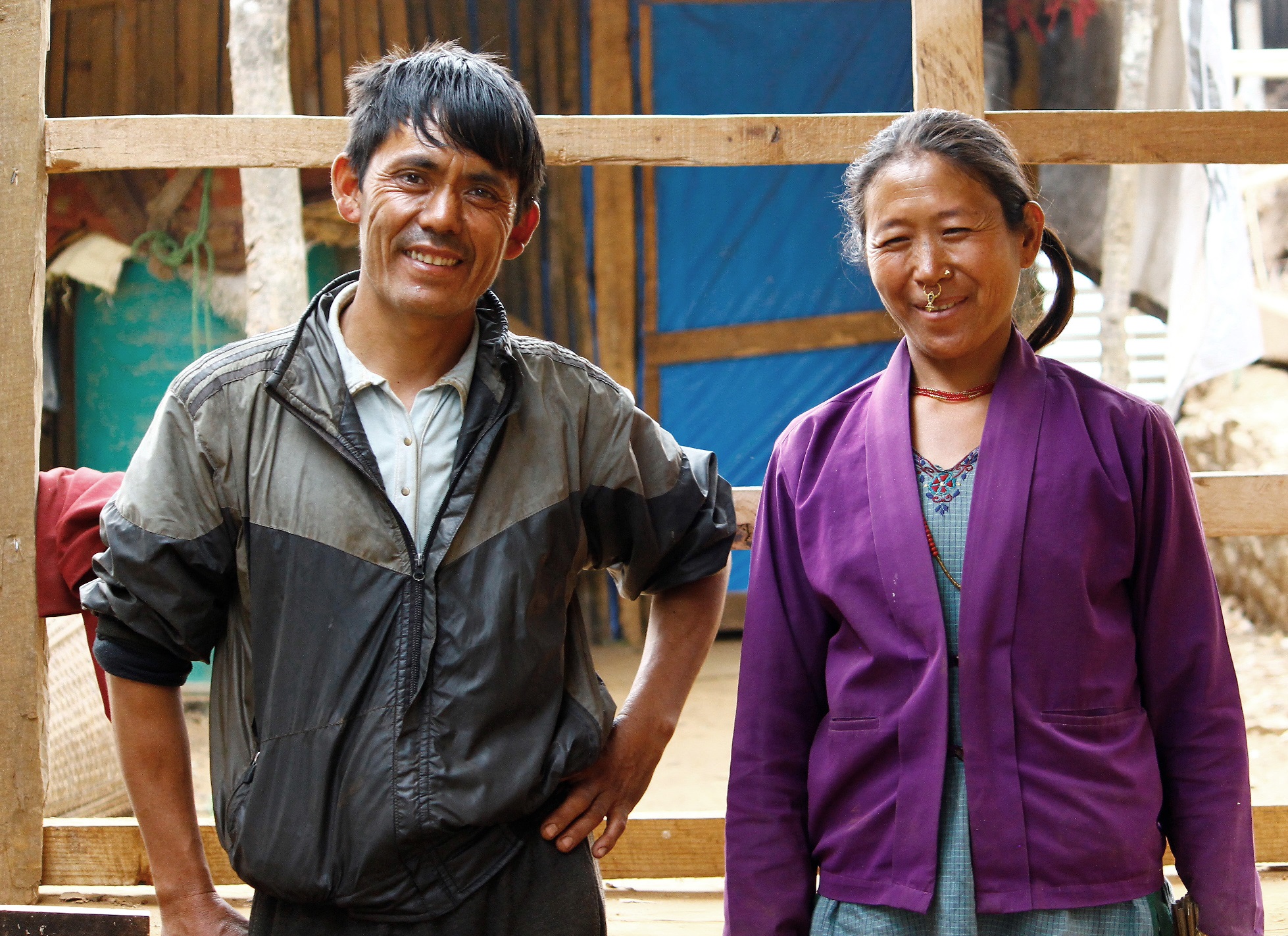地震发生后,联合国难民署分发了42,000块防水帆布予近21万流离失所者。其他的援助包括8000盏太阳能灯及兴建了175所临时学校。

Jagat Lama, 40, and his wife Dawa Sangmo, 41, smile as both take a break from building their new house in Baramchi Village in Sindhupalchowk district. Jagat's house was completely destroyed in the April 25 earthquake last year. One year on, many survivors still live in temporary shelters built with salvaged materials and tarpaulins distributed in the weeks after the quake. In the months that followed, the affected families faced challenges that included monsoon, shortages of essential supplies due to protest blockades on the Indian border, and surviving harsh winter. ; In April 2015, a magnitude 7.8 earthquake killed nearly 9,000 people and destroyed massive amounts of property, including numerous temples that were on the list of UNESCO World Heritage Sites. Working with international and Nepali partner organizations, UNHCR distributed shelter and lighting to affected communities in dire need last year. ; This image, video, audio or multimedia is copyrighted and may only be reproduced with permission from authorised staff at UNHCR. Images, video, audio and multimedia may only be used under licence for editorial use relating to UNHCR-supported issues and only where the content of the media is accurately represented and captioned. Use in a commercial or promotional context is not allowed. A credit is always required in the format '© UNHCR/Photographer' for photo images and '© UNHCR' for video, audio and multimedia unless stated otherwise.
于尼泊尔东北部山上的一条瓦砾遍地的Baramchi村庄,40岁的杰格德喇嘛(Jagat Lama)正在屋顶修理他新建的家,锤击铁板的声音打破了寂静。
杰格德是两个孩子的父亲,也是一年前尼泊尔7.8级地震后,数以万计尽力将生活重拾正轨的其中一名幸存者,他说:「我计划于雨季前搬进新房子」。
一年前大地震于4月25日中午袭击尼泊尔,杰格德和他的妻子,达瓦桑姆(Dawa Sangmo)当时正在距离村庄约一公里的田里种植粟米。他们立即奔跑回家发现家中情况,大家都被吓坏了。
「两层高的房子整幢消失了。大家都十分恐慌,不断叫喊,哭泣和奔跑。我当时几乎望不见前方超过数米外的情况,因为漫天纷飞的尘土覆盖整座山及村庄。」杰格德说。 「不消几秒钟,美丽的村庄好像被炸毁过一样。」
约8500人于地震中死亡,数十万房屋被催毁,其中大部分如Baramchi村这类较偏僻的地区,均无法得到紧急及医疗援助。正当居民于5月逐渐开始平复过来,第二次地震再度袭击,再有153人死亡。
随后的几个月,无家可归的家庭面临着严峻的挑战。包括六月至八月的暴雨,以及因印度边境封锁引致食物及必需品的短缺,继而持续的严寒更令居民雪上加霜。
其后杰格德和他的家人试过睡在满布稻草的森林内,也试过搬到倒塌的家附近一个梯田,再往后的三个月他们就以难民署提供的塑料帆布庇护下睡觉。
地震发生后,联合国难民署分发了42,000块防水帆布予近21万流离失所者。其他的援助包括8000盏太阳能灯及兴建了175所临时学校。
「于数个受地震重击的地区中,难民署是最先回应的机构,因为我们能即时调动于尼泊尔境内的防水帆布及太阳能灯储备,第一时间送往灾区。」难民署驻尼泊尔代表克雷格·桑德斯(Craig Sanders) 说。
「随着救灾工作规模扩大,我们集中使用创新的技术协助重建房屋和学校。尽管遇上不少挑战,例如后勤支援问题、地势的困难和广泛的破坏度,我们仍然能够到达最需要支援的社区。」
灾难发生后的数周,杰格德得到难民署提供的组装工具箱,支持居民自行搭建简单的庇护所。杰格德知道后十分兴奋:「没有难民署的支持,我应该无法自行搭建这样美好的房子。」
随后他借贷50,000卢比(约美金$475),为新房子添上门窗。他希望于邻居的田野干活,同时协助邻居建房子,赚取资金偿还贷款。
「我知道余震会继续,我们一直很害怕」他说。搬进新房子让我觉得安心一点,我真的很期待。 」